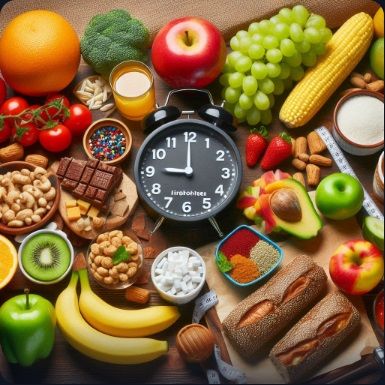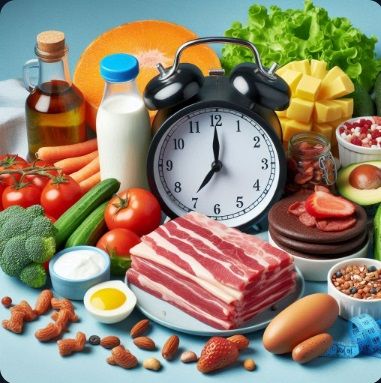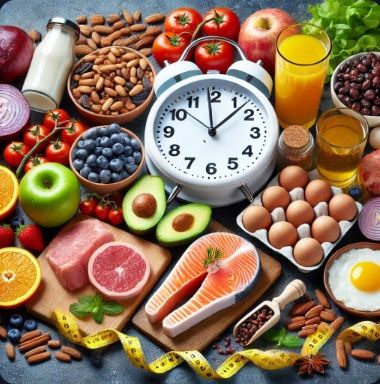
Nutrition
MyPlate is the new model for balanced nutrition. Unlike the traditional food pyramid, MyPlate emphasizes portion control and balanced meals. Below is the link.
MyPlate | U.S. Department of Agriculture
MACRONUTRIENT
Carbohydrates (4 kcal/g)
-
Primary Function: Provide the body with energy for daily activities, exercise, brain function, and metabolic processes.
-
Sources:
-
Whole Grains: Oats, brown rice, quinoa, whole wheat pasta, barley, millet, and whole grain bread.
-
Fruits: Apples, bananas, berries, oranges, grapes, mangoes, pineapples, and melons.
-

Vegetables: Broccoli, spinach, carrots, sweet potatoes, peas, bell peppers, cauliflower, and kale.
-
Legumes: Beans (black, kidney, pinto), lentils, chickpeas, split peas, and soybeans.
-
-
Types:
-
Simple Carbohydrates: Found in fruits, milk, and sugar. They provide quick energy but can lead to energy crashes if consumed in excess.
-
Complex Carbohydrates: Found in whole grains, starchy vegetables, and legumes. They provide sustained energy and help maintain stable blood sugar levels.
-
-
Fiber: A type of carbohydrate that aids in digestion, promotes satiety, and helps regulate blood sugar levels. Found in whole grains, fruits, vegetables, and legumes.
-
Recommended Intake: 45-65% of daily calories. Athletes or highly active individuals may need a higher percentage.
Proteins (4 kcal/g)
-
Primary Function: Build and repair tissues, produce enzymes, hormones, and other essential chemicals, support immune function, and serve as an energy source during prolonged exercise.
-
Sources:
-
Animal Proteins: Lean meats (chicken, turkey, beef, pork), fish (salmon, tuna, cod, sardines), eggs, and dairy

products (milk, yogurt, cheese).
-
Plant Proteins: Legumes (beans, lentils, chickpeas), tofu, tempeh, edamame, nuts (almonds, peanuts), seeds (chia, flax, pumpkin), quinoa, and whole grains.
-
-
Types:
-
Complete Proteins: Contain all nine essential amino acids (e.g., meat, fish, eggs, dairy, soy products like tofu and tempeh).
-
Incomplete Proteins: Lack one or more essential amino acids (e.g., grains, nuts, seeds, legumes). Combining different plant proteins can create a complete amino acid profile (e.g., rice and beans).
-
-
Recommended Intake: 10-35% of daily calories. Individuals involved in strength training or muscle-building activities may require higher protein intake.
Fats (9 kcal/g)
-
Primary Function: Provide a concentrated source of energy, protect organs, support cell growth, absorb certain vitamins (A, D, E, K), and produce important hormones.
-
Sources:
-
Healthy Fats: Avocados, nuts (almonds, walnuts, cashews), seeds (chia, flax, sunflower), olive oil, canola oil, fatty fish (salmon, mackerel, trout), and dark chocolate.

-
Saturated Fats: Found in butter, cheese, red meat, coconut oil, and palm oil. Should be consumed in moderation as they can raise LDL cholesterol levels.
-
Trans Fats: Found in some processed and fried foods, margarine, and baked goods. Should be avoided as much as possible as they can raise LDL cholesterol and lower HDL cholesterol.
-
-
Types:
-
Saturated Fats: Solid at room temperature, can raise LDL cholesterol levels, found in animal products and some plant oils.
-
Unsaturated Fats: Liquid at room temperature, can improve blood cholesterol levels.
-
Monounsaturated Fats: Found in olive oil, avocados, nuts, and seeds. Help reduce bad cholesterol levels and lower the risk of heart disease.
-
Polyunsaturated Fats: Found in fatty fish, flaxseeds, walnuts, and soybean oil. Include omega-3 and omega-6 fatty acids, which are essential for brain function and cell growth.
-
-
-
Recommended Intake: 20-35% of daily calories. Focus on healthy fats and limit saturated and trans fats.
Hydration:
-
Importance: Essential for digestion, nutrient absorption, temperature regulation, joint lubrication, and overall health.
-
Sources: Water, herbal teas, coconut water, fruits and vegetables with high water content (cucumbers, watermelon, oranges, strawberries, lettuce, celery).
-
Recommended Intake: Varies based on activity level, climate, and individual needs, but a general guideline is to drink at least 8 cups (64 ounces) of water per day.
Tips for Balanced Nutrition:
-
Meal Timing: Aim for balanced meals and snacks every 3-4 hours to maintain energy levels, metabolism, and prevent overeating.
-
Portion Control: Use visual cues like the plate method (half the plate with vegetables, a quarter with protein, and a quarter with whole grains) to ensure balanced portions.
-
Variety: Include a diverse range of foods to ensure a broad spectrum of nutrients and prevent dietary monotony. Rotate different fruits, vegetables, proteins, and grains.
-
Quality: Focus on whole, minimally processed foods for optimal nutrition and health benefits. Limit processed foods high in added sugars, unhealthy fats, and sodium.
-
Preparation: Plan and prepare meals in advance to ensure you always have nutritious options available. Batch cooking, meal prepping, and using leftovers creatively can save time and ensure balanced meals.